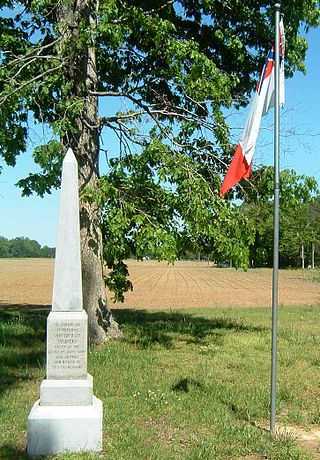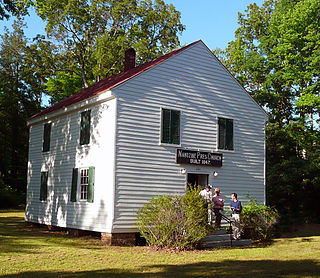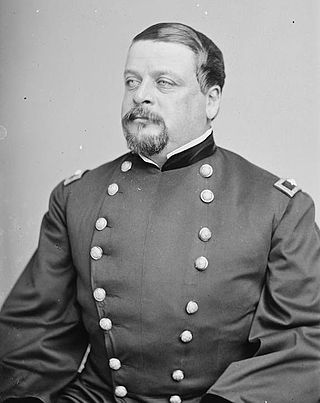
The Battle of the Wilderness was fought on May 5–7, 1864, during the American Civil War. It was the first battle of Lieutenant General Ulysses S. Grant's 1864 Virginia Overland Campaign against General Robert E. Lee and the Confederate Army of Northern Virginia. The fighting occurred in a wooded area near Locust Grove, Virginia, about 20 miles (32 km) west of Fredericksburg. Both armies suffered heavy casualties, nearly 29,000 in total, a harbinger of a war of attrition by Grant against Lee's army and, eventually, against the Confederate capital, Richmond, Virginia. The battle was tactically inconclusive, as Grant disengaged and then continued his offensive.

The Battle of Spotsylvania Court House, sometimes more simply referred to as the Battle of Spotsylvania, was the second major battle in Lt. Gen. Ulysses S. Grant and Maj. Gen. George G. Meade's 1864 Overland Campaign of the American Civil War. Following the bloody but inconclusive Battle of the Wilderness, Grant's army disengaged from Confederate General Robert E. Lee's army and moved to the southeast, attempting to lure Lee into battle under more favorable conditions. Elements of Lee's army beat the Union army to the critical crossroads of the Spotsylvania Court House in Spotsylvania County, Virginia, and began entrenching. Fighting occurred on and off from May 8 through May 21, 1864, as Grant tried various schemes to break the Confederate line. In the end, the battle was tactically inconclusive, but both sides declared victory. The Confederacy declared victory because they were able to hold their defenses. The United States declared victory because the Federal offensive continued and Lee's army suffered losses that could not be replaced. With almost 32,000 casualties on both sides, Spotsylvania was the costliest battle of the campaign.

The Battle of Cold Harbor was fought during the American Civil War near Mechanicsville, Virginia, from May 31 to June 12, 1864, with the most significant fighting occurring on June 3. It was one of the final battles of Union Lt. Gen. Ulysses S. Grant's Overland Campaign, and is remembered as one of American history's most lopsided battles. Thousands of Union soldiers were killed or wounded in the frontal assault of June 3 against the fortified positions of Confederate Gen. Robert E. Lee's army, an event that compounded the image of Grant's apparent disregard for high casualties.

The Richmond–Petersburg campaign was a series of battles around Petersburg, Virginia, fought from June 9, 1864, to March 25, 1865, during the American Civil War. Although it is more popularly known as the siege of Petersburg, it was not a classic military siege, in which a city is encircled with fortifications blocking all routes of ingress and egress, nor was it strictly limited to actions against Petersburg. The campaign consisted of nine months of trench warfare in which Union forces commanded by Lieutenant General Ulysses S. Grant assaulted Petersburg unsuccessfully and then constructed trench lines that eventually extended over 30 miles (48 km) from the eastern outskirts of Richmond, Virginia, to around the eastern and southern outskirts of Petersburg. Petersburg was crucial to the supply of Confederate General Robert E. Lee's army and the Confederate capital of Richmond. Numerous raids were conducted and battles fought in attempts to cut off the Richmond and Petersburg Railroad. Many of these battles caused the lengthening of the trench lines.

The Peninsula campaign of the American Civil War was a major Union operation launched in southeastern Virginia from March to July 1862, the first large-scale offensive in the Eastern Theater. The operation, commanded by Major General George B. McClellan, was an amphibious turning movement against the Confederate States Army in Northern Virginia, intended to capture the Confederate capital of Richmond. Despite the fact that Confederate spy Thomas Nelson Conrad had obtained documents describing McClellan's battle plans from a double agent in the War Department, McClellan was initially successful against the equally cautious General Joseph E. Johnston, but the emergence of the more aggressive General Robert E. Lee turned the subsequent Seven Days Battles into a humiliating Union defeat.

The Seven Days Battles were a series of seven battles over seven days from June 25 to July 1, 1862, near Richmond, Virginia, during the American Civil War. Confederate General Robert E. Lee drove the invading Union Army of the Potomac, commanded by Maj. Gen. George B. McClellan, away from Richmond and into a retreat down the Virginia Peninsula. The series of battles is sometimes known erroneously as the Seven Days Campaign, but it was actually the culmination of the Peninsula Campaign, not a separate campaign in its own right.

The Overland Campaign, also known as Grant's Overland Campaign and the Wilderness Campaign, was a series of battles fought in Virginia during May and June 1864, towards the end of the American Civil War. Lt. Gen. Ulysses S. Grant, general-in-chief of all Union armies, directed the actions of the Army of the Potomac, commanded by Maj. Gen. George G. Meade, and other forces against Confederate Gen. Robert E. Lee's Army of Northern Virginia. Although Grant suffered severe losses during the campaign, it was a strategic Union victory. It inflicted proportionately higher losses on Lee's army and maneuvered it into a siege at Richmond and Petersburg, Virginia, in just over eight weeks.

The Battle of Chaffin's Farm and New Market Heights, also known as Laurel Hill and combats at Forts Harrison, Johnson, and Gilmer, was fought in Virginia on September 29–30, 1864, as part of the siege of Petersburg in the American Civil War.

The Battle of Yellow Tavern was fought on May 11, 1864, as part of the Overland Campaign of the American Civil War. Union cavalry under Maj. Gen. Philip Sheridan was detached from Grant's Army of the Potomac to conduct a raid on Richmond, Virginia, and challenged Confederate cavalry commander Maj. Gen. J.E.B. Stuart. The Confederates were outnumbered, and Stuart was mortally wounded. However, Sheridan's 'sideshow' did not achieve any of its other objectives and had meanwhile deprived Grant's army of key cavalry functions at Spotsylvania.

The Battle of Totopotomoy Creek, also called the Battle of Bethesda Church, Crumps Creek, Shady Grove Road, and Hanovertown, was fought in Hanover County, Virginia on May 28–30, 1864, as part of Union Lt. Gen. Ulysses Grant's Overland Campaign against Confederate Gen. Robert E. Lee's Army of Northern Virginia.

The Battle of Haw's Shop or Enon Church was fought on May 28, 1864, in Hanover County, Virginia, as part of Union Lt. Gen. Ulysses S. Grant's Overland Campaign against Confederate Gen. Robert E. Lee's Army of Northern Virginia during the American Civil War.

The Battle of North Anna was fought May 23–26, 1864, as part of Union Lt. Gen. Ulysses S. Grant's Overland Campaign against Confederate Gen. Robert E. Lee's Army of Northern Virginia. It consisted of a series of small actions near the North Anna River in central Virginia rather than a general engagement between the armies. The individual actions are sometimes separately known as: Telegraph Road Bridge and Jericho Mills ; Ox Ford, Quarles Mill, and Hanover Junction.

The Battle of Trevilian Station was fought on June 11–12, 1864, in Union Lt. Gen. Ulysses S. Grant's Overland Campaign against Confederate Gen. Robert E. Lee's Army of Northern Virginia. Union cavalry under Maj. Gen. Philip Sheridan fought against Confederate cavalry under Maj. Gens. Wade Hampton and Fitzhugh Lee in the bloodiest and largest all-cavalry battle of the war.
The Battle of Saint Mary's Church was an American Civil War cavalry battle fought on June 24, 1864, as part of Union Lt. Gen. Ulysses S. Grant's Overland Campaign against Confederate Gen. Robert E. Lee's Army of Northern Virginia.

The Battle of Namozine Church was an engagement in Amelia County, Virginia, between Union Army and Confederate States Army forces that occurred on April 3, 1865, during the Appomattox Campaign of the American Civil War. The battle was the first engagement between units of General Robert E. Lee's Confederate Army of Northern Virginia after that army's evacuation of Petersburg and Richmond, Virginia, on April 2, 1865, and units of the Union Army under the immediate command of Maj. Gen. Philip Sheridan, who was still acting independently as commander of the Army of the Shenandoah, and under the overall direction of Union General-in-Chief Lt. Gen. Ulysses S. Grant. The forces immediately engaged in the battle were brigades of the cavalry division of Union Brig. Gen. and Brevet Maj. Gen. George Armstrong Custer, especially the brigade of Colonel and Brevet Brig. Gen. William Wells, and the Confederate rear guard cavalry brigades of Brig. Gen. William P. Roberts and Brig. Gen. Rufus Barringer and later in the engagement, Confederate infantry from the division of Maj. Gen. Bushrod Johnson.

Fort Pocahontas was an earthen fort on the north bank of the James River at Wilson's Wharf, in Charles City County, Virginia which served as a Union supply depot during the American Civil War. The fort was constructed by African-American soldiers of the United States Colored Troops under the command of Brig. Gen. Edward Augustus Wild.
The Second Battle of Deep Bottom, also known as Fussell's Mill, New Market Road, Bailey's Creek, Charles City Road, or White's Tavern, was fought August 14–20, 1864, at Deep Bottom in Henrico County, Virginia, during the Richmond-Petersburg Campaign of the American Civil War.
The Battle of Meadow Bridge was an engagement on May 12, 1864, in Henrico County, Virginia, during Lt. Gen. Ulysses S. Grant's Overland Campaign of the American Civil War. Following their victory at the Battle of Yellow Tavern on May 11, Union cavalry under Maj. Gen. Philip H. Sheridan advanced in the direction of the Confederate capital of Richmond. Caught in the narrow area between the fortifications of Richmond and the rain-swollen Chickahominy River, the Union troopers were subjected to fire from the artillery of Confederate Maj. Gen. Fitzhugh Lee. Michigan cavalry under Brig. Gen. George A. Custer forced a crossing of a damaged railroad bridge, which was quickly rebuilt by engineers, allowing the troopers to escape to safety and continue their raid.

Alfred Gibbs was a career officer in the United States Army who served as an officer during the Mexican-American War and Apache Wars. He served as a brigadier general in the Union Army during the American Civil War.
The Battle of Vaughan Road, also spelled "Vaughn", was an American Civil War engagement between Confederate States Army and Union Army cavalry forces protecting the flank of the main Union attack on Confederate positions on the western end of the Confederate line on October 1, 1864 during the Battle of Peebles' Farm, part of the Siege of Petersburg. The Union force repulsed Confederate attacks and protected ground just gained at McDowell's Farm and an important road junction on the Vaughan Road at the Wyatt Road. They inflicted about 130 casualties on the Confederates while losing about 90 men, about half of whom were taken prisoner. During the battle, Confederate Brigadier General John Dunovant was killed. Union Army Sergeant James T. Clancy, who was awarded the Medal of Honor on July 3, 1865, was credited with firing the fatal shot.
















